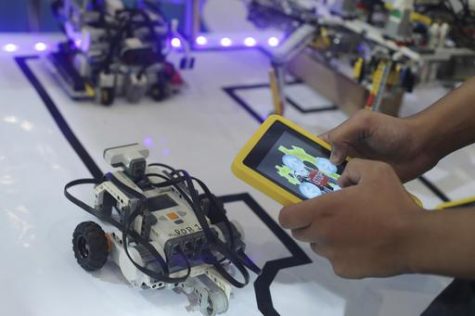Benefits of Technology in a School Setting
December 19, 2016
Technology. A term defined by Merriam Webster as, “a manner of accomplishing a task using technical processes, methods, or knowledge.” This term, however, means much more to teenagers, for it allows them to fully express themselves and to meet new people across the world. With school being a daily and important part of each teenager’s life, the use of technology is expected, and should be allowed throughout their academic careers.
According to a study by IT Trade Association Comp TIA, around 75 percent of educators think that technology has a positive impact in the education process.
Additionally, the access to new and helpful resources for students would not be possible without technology. According to the Pew Research Center, 92 percent of teachers said that the Internet has a major impact on their ability to access content, resources and materials. Also, many are finding that it helps their ability to interact with students.
Teachers can use websites such as Edmodo, Moodle, and Canvas that provide an opportunity to share resources with students, as well as help them stay on top of assignments and tests.

Over the last 50 years, the world has evolved immensely because of the advances made in the technological field. Now, students of all grades are expected to be able to perform tasks on devices such as iPads, iPhones, and laptops.
Based upon data from a securedgenetwork’s blog, technology has become even more necessary in order to be successful citizens. The author also said that students must learn to be tech-savvy. Now, information from NCES showed that in 2013, 71 percent of the U.S. population age three and over used the Internet; that number has increased over the past three years due to multiple advances in the technological field.
However, some educators have a hard time accepting technology in their classrooms because of the distraction they cause. That very opinion, though should surrender to the retention rate statistics for students when using technology.
A study found by Teachhub stated that eighteen second grade students were to complete a Power Point project about an animal. Sixteen of the eighteen students remembered more facts about the animal after completing the presentation, thus showing that technology helps students remember what they learn through the use of technology to present and retain information.
Furthermore, this generation is a generation of creativity. It is a time period where differences are encouraged, and creative “juices” have the opportunity to shine.
When used correctly, the platform of technology can allow students to engage through curiosity and collaboration. According to Educator’s Technology, 96% view that technology helped students share their work with a wider and more varied audience. Another 79% agree that digital technologies encourage wider collaboration among students and boost student creativity and personal expression.
Technology is the epitome of this generation. Students are relying on their phones, tablets, laptops, and many more for their day to day school work and other assignments. Without it, students would be forced to rely on traditional pen and paper, rather than being able to explore a more creative route with technology.
As technological advances continue to happen, teachers need to help students adapt to that. Technology introduces students to the world outside their own, and can be come accustomed to new people and traditions, and that very introduction should begin in school.








